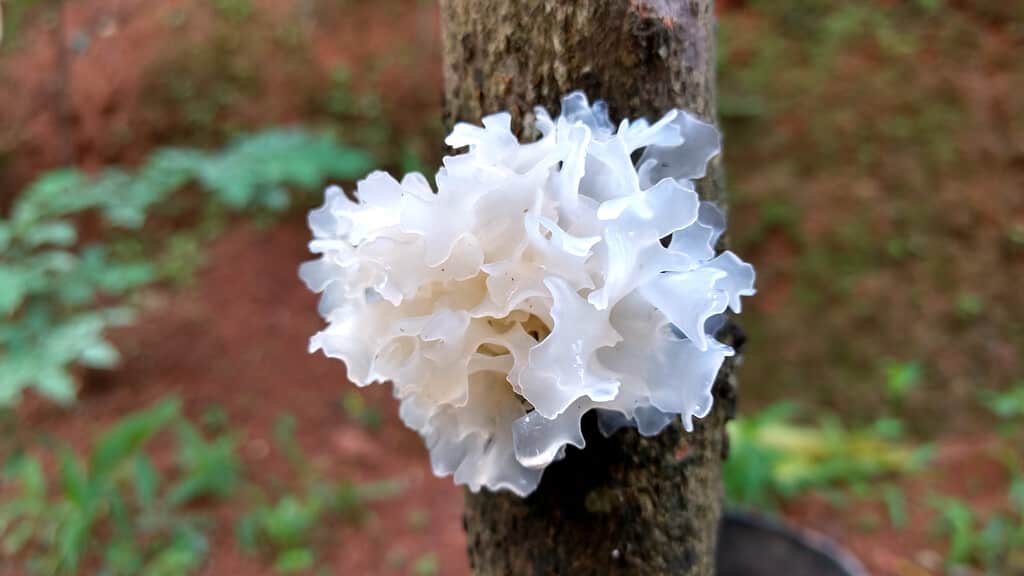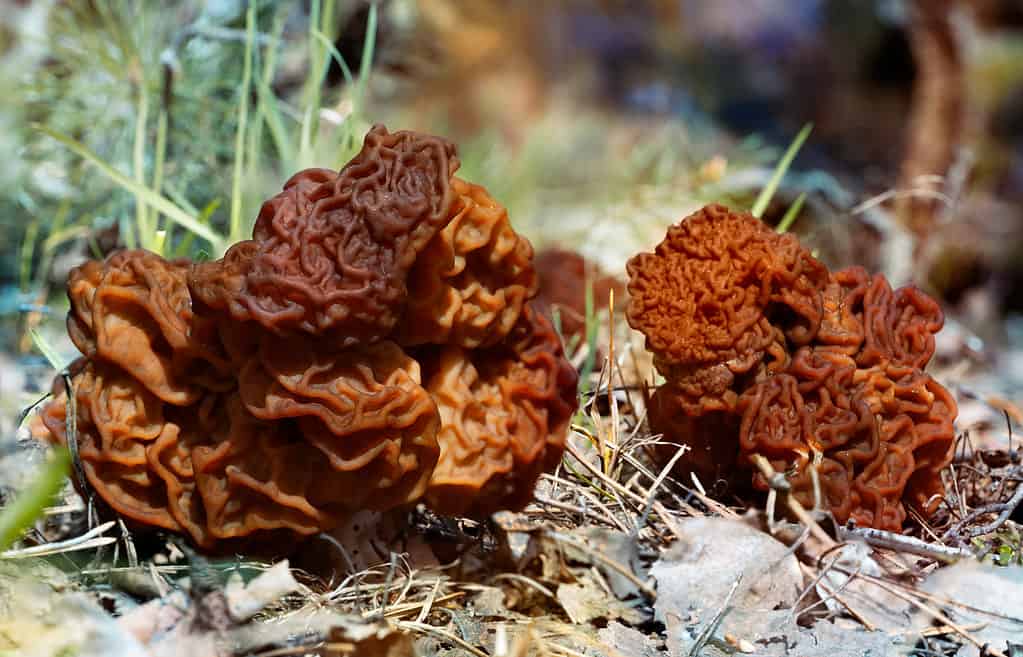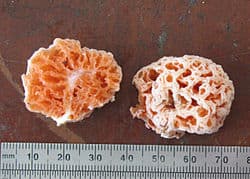While strolling along a forest trail, you may have come across sponge-like fungi fruiting from a tree, scattered across the ground, or growing from deadwood along the forest floor. Mushrooms that look like sponges abound across several fungal families.
In this guide, we’ll talk about four delightful mushrooms that look like sponges, where they grow, their ecological roles, how to identify them, and what uses humans may have for them.
Read on to learn more.
Mushrooms That Look Like Sponges: Snow Fungus (Tremella fuciformis)
A jelly fungus that most commonly grows in tropical, subtropical, and temperate forested environments, the snow fungus (Tremella fuciformis) looks quite like some species of sea sponges in the Hippospongia genus, especially when dried.
Ecological Roles
Tremella fuciformis displays the potential for a couple of distinct ecological relationships. It often grows alongside Annulohypoxylon archeri or Annulohypoxylon stygium. It may be parasitic on the Annulohypoxylon mycelium or have an undetermined mutualistic relationship with the fungi. What is clear is that these species of Annulohypoxylon enable Tremella fuciformis to produce fruiting bodies.
Tremella fuciformis may require the presence of Annulohypoxlyon to break down certain components of the dead hardwood into usable nutrients. With the wood in a usable form, the mycelium of Tremella fuciformis may be able to accumulate enough energy to produce fruiting bodies. The snow fungus fruiting bodies may grow alone or in number among Annulohypoxylon archeri or A. stygium fruiting bodies on decaying logs, branches, and twigs of hardwoods.
Identifying the Snow Fungus
The fruiting body of the snow fungus is gelatinous but with a fairly firm structure. It features a glob-like form of branching lobes that are translucent-white. As it matures, the lobes expand into a broader, flat shape. When moist, the surface is smooth and shiny. A mature fruiting body can grow up to 3 inches across and 1.5 inches tall. Its spore print is white. This fruiting body does not feature a stem-and-cap formation or have visible pores, teeth, or gills.
In North America, you can most commonly find Tremella fuciformis fruiting east of the Rocky Mountains in the summer and fall. Ductifera pululahuana can look similar to the untrained eye, but it is less translucent, and the morphology is somewhat different.
Human Uses of the Snow Fungus
Tremella fuciformis is an edible species. Additionally, research demonstrates that this fungus contains several bioactive compounds, some of which may have beneficial health effects on people. In particular, the snow fungus is an important edible and medicinal mushroom in traditional Chinese medicine. Over the past few decades, researchers have reported that Tremella fuciformis contains polysaccharides with a range of bioactive effects, including anti-tumor, anti-inflammatory, hypoglycemic, and memory improvement.
In East Asia in particular, the snow fungus is a popular ingredient in a variety of dishes from soups to desserts. You can typically purchase fruiting bodies dried in packages at markets that sell an array of dried fungi. In cultivation, people typically grow this fungus in combination with its companion fungi in the Annulohypoxylon genus.

is popularly used in skin creams in Asia.
©Ashish Sayani/Shutterstock.com
Mushrooms That Look Like Sponges: Morels (Morchella spp.)
If you’ve ever had the joy of finding wild morels, you may have noticed how sponge-like the caps appear. This is especially apparent in yellow morels species of the esculenta clade. Morchella americana, or the blonde morel, is one of the most widely occurring species in the esculenta clade to appear in the U.S.
Ecological Roles
Morels of the esculenta clade, such as Morchella americana, appear to form associations with various tree species. Ongoing research might prove that some species of morels may form a mutualistic relationship with the roots of these trees. This relationship between the mycelium of fungi and the roots of plants is known as mycorrhizal. This mycorrhizal relationship is based on a nutrient exchange that benefits both organisms. Morels that form associations with trees may also exhibit saprobic behaviors at points in their life cycles. As a saprobic fungus, the mycelium obtains nutrients through breaking down dead organic matter, such as deadwood or leaf litter.
Notably, morels in the rufobrunnea clade do not appear to form associations with trees. Instead, these morel species, such as Morchella rufobrunnea, are primarily saprobic. In the case of M. rufobrunnea, they tend to grow in woodchips and highly decomposed wood material. Morels appear throughout spring.
How to Identify Morchella spp.
There are some distinctive features that all true morels share. These mushrooms form a fruiting body consisting of a stem (aka stipe) and cap. The cap of a morel is quite distinct in appearance, featuring a honeycomb-like structure of ridges and pits. The cap is also what gives morels such as Morchella americana its sponge-like appearance.
The majority of true morels in the Morchella genus have a cap that is fully attached to the sipe. This means that the bottom of the caps does not freely overhang the stipe. The exception occurs with half-free morels in which the bottom of the cap is only partially attached to the stipe. An example of this formation is found in Morchella semilibera. All morels in the Morchella genus feature a fully or mostly hollow cap and stipe.
In the case of Morchella americana, specifically, you may find that young specimens are grayish. As they mature, the ridge and pit color typically changes to a yellow or yellow-brown. The stipe of this species can measure up to 5 inches tall. The cap typically measures up to 4 inches in height, although taller specimens have been reported. This species does not bruise when sliced and the cap is firmly attached to the stipe. The blonde morel tends to be fully hollow in the stipe and cap.
Human Uses of Morels
Most folks forage morels for their meaty texture and nutty, earthy, and rich flavor profile. You can purchase dried morels year-round at many gourmet or health food stores and international markets. Whether you obtain a dry or fresh morel mushroom, it’s extremely important to thoroughly cook before eating. When consumed raw or undercooked, these mushrooms can cause a range of distressing GI and neurological symptoms. Eating raw morels has even been linked to deaths, as is the recent case with the poisoning of about 50 customers at a sushi restaurant in Montana. In this case, of the 50 people poisoned by consuming raw and undercooked morels, two people died.
The harmful toxins present in raw morels are heat-labile, however, meaning they are destroyed by cooking. Some people still experience some mild GI distress when consuming even thoroughly cooked morels, so it’s always a good idea to eat a small amount when you’re first trying them. Ideally, wait at least 24 hours to assess how you feel before eating more.

Prized for their flavor, morels must be cooked thoroughly before eating.
©Mircea Costina/Shutterstock.com
Mushrooms That Look Like Sponges: Brain Mushrooms (Gyromitra spp.)
If you’re going to forage for morels, it’s important to be aware of their toxic lookalikes which primarily include some species of brain mushrooms that look like sponges (Gyromitra spp.). In particular, the false morel and the Carolina false morel (Gyromitra esculenta and Gyromitra caroliniana) are sponge-like mushrooms that bear some superficial resemblances to morels.
Ecological Roles of Brain Mushrooms
Like true morels, mushrooms in Gyromitra typically appear in springtime. They also tend to grow in similar environments to species in Morchella that form associations with trees. Like true morels of the esculenta and elata clade, mushrooms in Gyromitra may form mycorrhizal relationships with the roots of various tree species. While they are officially considered saprobic, more research may reveal a more complicated life cycle.
Gyromitra caroliniana tends to appear in the spring under hardwood and often near rotting stumps and downed trees. Gyromitra esculenta primarily occurs in the spring under conifer trees.
How to Identify Brain Mushrooms
When comparing true morels with species in Gyromitra, you’ll notice a few distinctions. While Morchella features fruiting bodies with a hollow or nearly hollow stipe and cap, Gyromitra is not hollow inside. The flesh may be chambered but will still appear substantial. Additionally, you’ll notice the caps of species in Gyromitra, like Gyromitra esculenta, are more brain-like than morels. Instead of featuring a honeycomb-like structure, the caps of brain mushrooms don’t contain true deep pits and ridges. The cap also tends to have a more wrinkly and less conical appearance compared to morels.
Several species in Gyromitra, such as Gyromitra caroliniana, feature bulbous stipes that tend to contain vertical ridges. Overall, brain mushrooms are usually far less uniform or symmetrical in appearance compared to Morchella. Finally, the caps of brain mushrooms hang freely over the stipe, with only the center of the cap firmly attached to the stipe.
Human Uses of Brain Mushrooms
The edibility of mushrooms in Gyromitra is currently contested. In some regions of the world, particularly the Great Lakes region of the U.S., Finland, Poland, and Bulgaria, Gyromitra esculenta is a highly regarded culinary mushroom after special prep. However, the sale of mushrooms in Gyromitra is banned in Sweden, Norway, and Spain.
The neurotoxin, gyromitrin, is the reason for the debate regarding the edibility of brain mushrooms. Some reports claim that gyromitrin is heat-labile and thus degrades with proper cooking. However, the cooking process usually described is not simple and typically involves long periods of boiling the mushrooms, changing the water, and boiling again. The steam can contain gyromitrin and people have to make sure to not inhale the vapors as the mushrooms cook.
Even after all of this careful preparation, some reports show that the percentage of gyromitrin destroyed through boiling is highly variable. Additionally, one study demonstrates a possible connection between repetitive consumption of Gyromitra esculenta in the French Alps and the development of the fatal and devastating motor neuron disease, amyotrophic lateral sclerosis (ALS).

False morels look like they could easily be used as a sponge.
©Ksenia Lada/Shutterstock.com
Mushrooms That Look Like Sponges: Cauliflower Mushrooms (Sparassis spp.)
Widely distributed across temperate, forested regions in Asia, North America, North Africa, and Europe, cauliflower mushrooms (Sparassis spp.) are unique-looking fungi that produce sponge-resembling fruiting bodies. In particular, cauliflower mushrooms resemble the honeycomb sea sponge, Hippospongia communis.
Ecology
Most species in Sparassis demonstrate both parasitic and saprobic behaviors. Sparassis radicata, for example, often occurs at the base of conifers. It typically reoccurs yearly in the same location and causes a brown rot at the base of the host tree. In addition to growing a the base of a live tree, you may also find some species fruiting on leaf litter or deadwood. They tend to fruit from summer through fall, although some species may fruit during the winter in mild temperate climates.
How to Identify Cauliflower Mushrooms
There are at least three species of Sparassis that exist in North America including Sparassis radicata, S. americana, and S. spathulata. These species average about 4-12 inches wide, although some specimens have been found measuring 24 inches across. They typically grow up to 6-12 inches high. The fruiting body is comprised of a mass of off-white, yellowish, or yellow-brown flat, wavy-edged branches. Fresh fruiting bodies are flexible and slightly rubbery. Irpex rosettiformis can look quite similar, but is normally much smaller and found in more tropical environments.
Human Uses of Cauliflower Mushrooms
These mushrooms that look like sponges are highly regarded as an excellent, choice edible. They don’t have toxic lookalikes and are therefore a great mushroom for beginner foragers to search for. Some popular culinary uses include cauliflower mushroom “steaks”, stir-fries, and a vegan meat crumble in tacos.

Cauliflower mushrooms can look exactly like a sponge.
©Dorota Szymczyk/Shutterstock.com
Spongebob Squarepants Mushroom (Spongiforma squarepantsii)
A list of mushrooms that look like sponges wouldn’t be complete without mentioning the Spongebob Squarepants mushroom (Spongiforma squarepantsii). Described as a new species by a trio of cheeky mycologists in 2011, this adorably-named mushroom was discovered in Malaysia and belongs to the Boletaceae family. While you can frequently find mushrooms with silly common names, it’s quite rarer to come across a mushroom with an equally whimsical scientific name. To the scientists who dubbed this quaint mushroom Spongiforma squarepantsii, we tip our pirate hats to you.
Ecological Roles
There are currently only two species in the Spongiforma genus. Spongiforma squarepantsii is currently only known to exist in Malaysia, while its relative, Spongiforma thailandica, is native to Thailand. Both species occur in tropical rainforest environments.
Currently, the ecological behaviors and spore dispersal methods of the Spongebob Squarepants mushroom are not fully proven. The fruiting body does not discharge its spores from its cell. Instead, they act more like gasteromycetes, such as puffballs, which depend on an external force for spore dispersal. The strong, musky odor of the fruiting body is consistent with fungi, such as stinkhorns, that attract animals to them via their stench. The animals feed on the fruiting body and spread its spores in the process.
Due to its placement in the mycorrhizal-dominant Boletaceae family and preference for growing among trees that typically form mycorrhizal relationships, mycologists are currently investigating if the Spongebob Squarepants mushroom forms this mutualistic plant-fungi nutrient exchange.
How to Identify the Spongebob Squarepants Mushroom
The Spongiforma genus is unique among the Boletaceae family. Unlike the vast majority of the hundreds of species in this fungal family, the two species in Spongiforma do not produce stipe-and-cap fruiting bodies. Instead, they grow as sponge-like masses.
Spongiforma squarepantsii produces a pitted, orange, sponge-like fruiting body. This interesting gasteroid bolete behaves quite like a real sponge in that you can ring out excess water and the mushroom will conform back to its original size. Additionally, you may find dried specimens that can revive quickly when soaked in water. Interestingly, the fruiting body turns purple when sprinkled with a potassium hydrochloride solution.
This rubbery, sponge-like mushroom can reach sizes of 4 inches wide and about 3 inches tall. The flesh is orange on the inside.
Human Uses of the Spongebob Squarepants Mushroom
Currently, the edibility and potential medicinal properties of the Spongebob Squarepants mushroom are unknown. Thanks to its whimsical name and unique characteristics, however, it does provide quite a bit of intrigue for mycophiles and anyone who enjoys mixing serious science with a bit of frivolity.

We still have a lot to learn about this rare and unusual mushroom with a fun name.
©Tom Bruns (pogon) / https://mushroomobserver.org/images/151595 / CC BY-SA 3.0 DEED https://creativecommons.org/licenses/by-sa/3.0/ – Original / License
The photo featured at the top of this post is © petratrollgrafik/Shutterstock.com
The information presented on or through the Website is made available solely for general informational purposes. We do not warrant the accuracy, completeness, or usefulness of this information. Any reliance you place on such information is strictly at your own risk. We disclaim all liability and responsibility arising from any reliance placed on such materials by you or any other visitor to the Website, or by anyone who may be informed of any of its contents. None of the statements or claims on the Website should be taken as medical advice, health advice, or as confirmation that a plant, fungus, or other item is safe for consumption or will provide any health benefits. Anyone considering the health benefits of particular plant, fungus, or other item should first consult with a doctor or other medical professional. The statements made within this Website have not been evaluated by the Food and Drug Administration. These statements are not intended to diagnose, treat, cure or prevent any disease.
Thank you for reading! Have some feedback for us? Contact the AZ Animals editorial team.







